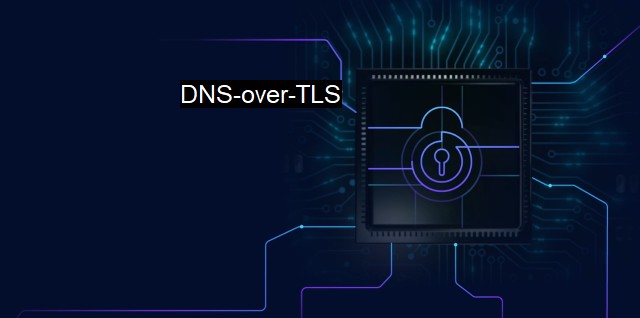What is DNS-over-TLS?
Securing DNS Communication with DNS-over-TLS: Enhancing Security in the Cyber Threat Landscape
Domain Name System over Transport Layer Security, often abbreviated as DNS-over-TLS or DoT, is a security protocol specifically designed for internet privacy protection. It works by wrapping DNS requests and responses with a layer of TLS encryption. it enables DNS clients, like your computer, to acquire DNS services over a network in a secure manner – a key consideration in today’s increasingly digital cybersecurity landscape.The Domain Name System or DNS was invented to convert readable domain names into numerical IP addresses. it was never designed to be secure. By standard, DNS queries and responses are sent in plain text across the network, which means that potentially anyone along the path can read, change, or misuse them. This security gap, which leaves open a chance for cybercriminals to interfere, has remained largely problematic.
DNS-over-TLS, or DoT, was introduced as a solution to these inherent risks. Essentially countering the limitations of the traditional DNS environment, DoT puts an extra layer of security by encrypting DNS queries and responses using The Transport Layer Security (TLS) protocol. This added layer of encryption essentially shields DNS queries and responses from unauthorized access and manipulation. Hence, even if data is intercepted, it will be unreadable due to the encryption.
The use of TLS is, at its heart, an initiative taken to establish private connections over the internet. It is a protocol primarily designed to enhance privacy and data security between multiple applications by creating a secured connection between two ends over a network. In the context of DNS-over-TLS, TLS offers an additional protective barrier, making it increasingly difficult for malicious entities to abuse DNS.
Within the cybersecurity space, DNS-over-TLS plays a crucial role in our ongoing fight against cyber threats. Lack of cybersecurity measures exposes one's online activities to be viewed, intercepted, or tampered with by unauthorized individuals. By standardizing the use of DNS-over-TLS, it makes for an inherently stronger internet infrastructure.
The DNS-over-TLS protocol isn't a silver bullet solution for all DNS related threats and challenges. Although it helps protect against threats such as Man-in-the-Middle attacks and eavesdropping, it does not inherently provide protection against malicious content or websites, nor does it verify the validity of the websites a user accesses. Thus, additional components such as antivirus software still have a significant role in cybersecurity solutions.
Besides its security benefits, DoT can one day present issues of its own. One concern is the centralization of DNS services. The vast majority of DoT queries today are served by a very few large entities. This centralization may expose users to different risks, including large-scale monitoring, single point of failure, and security questions regarding the data collected and how it is retained by these businesses.
Other potential criticism of DoT could be about the additional overhead of the encrypted tunnel for each DNS query. This would lead to an increased latency or slower internet speed. But, as performance optimization remains an ongoing process, gradual improvements in infrastructure and optimization tools are plausible moving forward.
Conclusionally, DNS-over-TLS provides an important tool in protecting privacy and security online. While this technology has its limitations and potential future concerns, it serves as a considerable step forward in the fight against cyber threats. Combined with robust antivirus software and cybersecurity protocols, it can help create a significantly safer digital environment.

DNS-over-TLS FAQs
What is DNS-over-TLS (DoT)?
DNS-over-TLS (DoT) is a security protocol that enables the encryption of all DNS traffic between the client and resolver using the Transport Layer Security (TLS) protocol. It is designed to enhance security and privacy of DNS queries and prevent DNS Spoofing attacks.How does DNS-over-TLS improve cybersecurity protection?
DNS-over-TLS enhances security by encrypting DNS queries and responses, which prevents eavesdropping and man-in-the-middle (MITM) attacks. This makes it more difficult for attackers to obtain sensitive information such as website history or user credentials. Also, it makes it difficult for attackers to tamper with DNS responses, preventing DNS Spoofing attacks that redirect users to phishing sites or other malicious domains.Are there any downsides to using DNS-over-TLS?
One of the main downsides to using DNS-over-TLS is the potential for slower DNS resolution times. This is because the process of encrypting and decrypting DNS queries and responses adds additional processing time. Furthermore, some older devices or routers may not support DNS-over-TLS, making it difficult to implement on all systems.How does DNS-over-TLS affect antivirus protection?
DNS-over-TLS does not directly affect antivirus protection. However, it can improve security by preventing malware from executing DNS Spoofing attacks, allowing antivirus software to better detect and prevent malicious activity on the network. Additionally, it can prevent malware from communicating with command-and-control (C&C) servers, making it more difficult for attackers to control infected machines.Related Topics
Cybersecurity Encryption Secure Sockets Layer (SSL) Antivirus Public Key Infrastructure (PKI)
| | A | | | B | | | C | | | D | | | E | | | F | | | G | | | H | | | I | | | J | | | K | | | L | | | M | |
| | N | | | O | | | P | | | Q | | | R | | | S | | | T | | | U | | | V | | | W | | | X | | | Y | | | Z | |
| | 1 | | | 2 | | | 3 | | | 4 | | | 7 | | | 8 | | |||||||